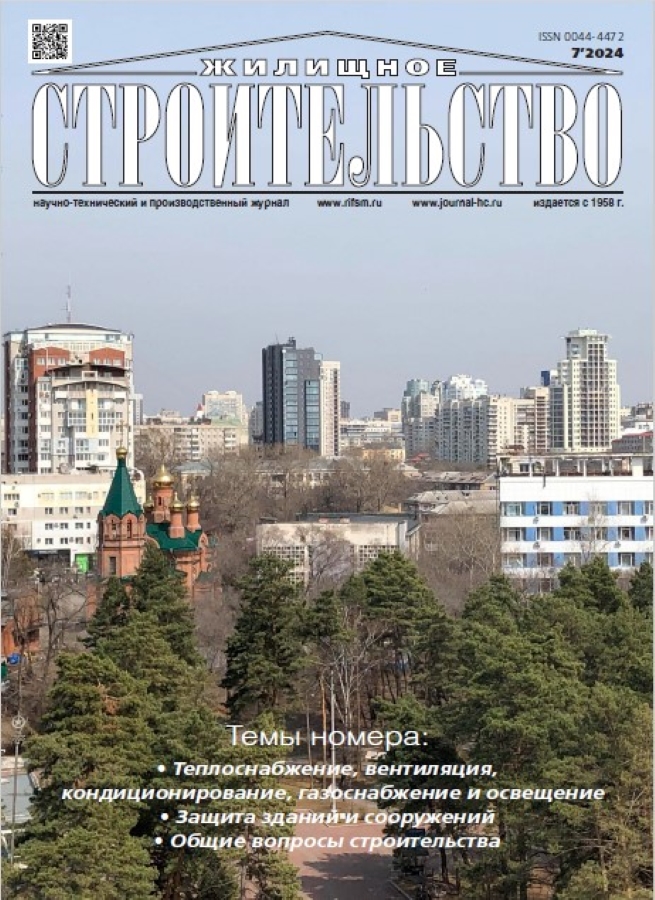Field studies of solar radiation transmission by glazing with multifunctional coatings
- Autores: Shubin I.L.1, Korkina E.V.1,2, Shmarov I.A.1, Kucherov S.S.2
-
Afiliações:
- Scientific-Research Institute of Building Physics of RAACS
- National Research Moscow State University of Civil Engineering
- Edição: Nº 7 (2024)
- Páginas: 8-14
- Seção: Articles
- URL: https://gynecology.orscience.ru/0044-4472/article/view/634798
- DOI: https://doi.org/10.31659/0044-4472-2024-7-8-14
- ID: 634798
Citar
Texto integral
Resumo
In order to reduce energy consumption for heating, ventilation and air conditioning, multi-functional and sun-protective glazing is installed in translucent faсades. In this case, the coefficient of transmittance of visible light and solar radiation is used in calculations of the coefficient of natural illumination of building premises and incoming solar radiation. These coefficients are determined at normal incidence of solar radiation on the glazing, according to normative documents. However, in real conditions, the angle of incidence is different from the normal angle of incidence. National and foreign research works on this issue have been carried out in laboratory conditions, while in fieldwork the effects related to the physical processes of interaction of radiation with sun-protective coatings may appear. At present, research is being carried out in NIISF RAASN to determine the empirical dependence of transmittance coefficients of glazing with special coatings on the angle of incidence of sunlight. This paper is part of this research and deals with the determination under in-situ conditions of the transmittance of solar radiation in the visible range by glazing with multifunctional and sun-protective coatings as a function of its orientation on the sides of light.
Texto integral
Sobre autores
I. Shubin
Scientific-Research Institute of Building Physics of RAACS
Autor responsável pela correspondência
Email: shuig@mail.ru
Doctor of Sciences (Engineering), Corresponding member of RAACS
Rússia, 21, Lokomotivniy Driveway, Moscow, 127238E. Korkina
Scientific-Research Institute of Building Physics of RAACS; National Research Moscow State University of Civil Engineering
Email: elena.v.korkina@gmail.com
Candidate of Sciences (Engineering)
Rússia, 21, Lokomotivniy Driveway, Moscow, 127238; 26, Yaroslavskoe Highway, Moscow, 129337I. Shmarov
Scientific-Research Institute of Building Physics of RAACS
Email: shmarovigor@yandex.ru
Candidate of Sciences (Engineering)
Rússia, 21, Lokomotivniy Driveway, Moscow, 127238S. Kucherov
National Research Moscow State University of Civil Engineering
Email: wysifalay@yandex.ru
Engineer
Rússia, 26, Yaroslavskoe Highway, Moscow, 129337Bibliografia
- Shubin I.L., Umnyakova N.P., Matveeva I.V., Andrianov K.A. Quality of the building envelope is the basis for creating an environmentally friendly environment of vital activity. Zhilishchnoe Stroitel’stvo [Housing Construction]. 2019. No. 6, pp. 10–15. (In Russian). DOI: https://doi.org/10.31659/0044-4472-2019-6-10-15
- Shchepetkov N.I. The science of light in the theory and art of architecture. Arhitektura i stroitel’stvo Rossii. 2022. No. 4, pp. 60–65. (In Russian).
- Spiridonov A.V., Shubin I.L. Safety glazing for ‘glass’ buildings. Arhitektura i stroitel’stvo Omskoj oblasti. 2021. No. 158, p. 44. (In Russian).
- Datsyuk T.A., Kurenkova A.Yu. The real situation of inspecting translucent structures In Russia. Svetoprozrachnye konstrukcii. 2020. No. 1–2 (129–130), pp. 13–15. (In Russian).
- Datsyuk T., Leontieva Y., Sokolov A., Mellekh T. Evaluating and ensuring the environmental safety of buildings. Lecture Notes in Civil Engineering. 2023. Vol. 257, pp. 75–84. https://doi.org/10.1007/978-3-030-99877-6_9
- Dvoreckij A.T., Spiridonov A.V., Shubin I.L. Nizkoenergeticheskie zdaniya: okna, fasady, solncezashchita, energoeffektivnost’ [Low energy buildings: windows, facades, sun protection, energy efficiency] Moscow: Direct-Media. 2022. 232 p.
- Soloviev A.K., Dorozhkina E.A. Modern understanding of the role of day lighting in the design of buildings. Zhilishchnoe Stroitel’stvo [Housing Construction]. 2021. No. 11, pp. 46–52. (In Russian). DOI: https://doi.org/10.31659/0044-4472-2021-11-46-52
- Kupriyanov V., Sedova F. Energy method for calculating insolation of residential apartments. IOP conference series. Materials Science and Engineering. Kazan. 2020. 012038. (In Russian). https://doi.org/10.1088/1757-899X/890/1/012038
- Roos A., Nijnatten P., Hutchins M.G., Polato P., Olive F. and Anderson C. Angular dependent optical properties of low-e and solar control windows – simulations versus measurements. Solar Energy. 2001. No. 69, pp. 15–26. https://doi.org/10.1016/S0038-092X(01)00019-6
- Faye I., Ndiaye A., Mamadou E. Influence of the incidence angle modifier and radiation as a function of the module performance for monocrystalline textured glass and no textured in outdoor exposed. 2021. https://doi.org/10.5772/intechopen.96160
- Karlsson J., Karlsson B., Roos A. A simple model for assessing the energy performance of windows. Energy and Buildings. 2001. No. 69, pp. 641–651. https://doi.org/10.1016/S0378-7788(00)00131-6
- Reber G., Steiner R., Oelhafen P. and Romanyuk A. Angular dependent solar gain for insulating glasses from experimental optical and thermal data. CISBAT Proceedings. EPFL. 2005, pp. 173–178.
- Blieske U., Stollwerck G. Glass and other encapsulation materials. Semiconductors and Semimetals. 2013. Vol. 89, pp. 199–258. https://doi.org/10.1016/B978-0-12-381343-5.00004-5
- Sadman Sakib Rahman, Kawsar Alam. Effect of angle of incidence on the performance of bulk heterojunction organic solar cells: A unified optoelectronic analytical framework. AIP Advances. 2017. No. 7. 065101. DOI: https://doi.org/10.1063/1.4985049
- Gorbarenko E.V., Rublev A.N., Bunina N.A. Modelling of natural illuminance in a cloudless atmosphere. Proceedings of the Main Geophysical Observatory named after. A.I. Voeykova. 2021. No. 603, pp. 49–65. (In Russian).
- Shubin I.L., Korkina E.V., Zemtsov V.V., Kucherov S.S. Dependence of the light transmission coefficients of multifunctional glazing on the angle o incidence of radiation. Zhilishchnoe Stroitel’stvo [Housing Construction]. 2024. No. 6, pp. 3–9. (In Russian). DOI: https://doi.org/10.31659/0044-4472-2024-6-3-9
Arquivos suplementares















